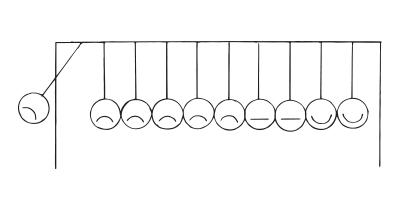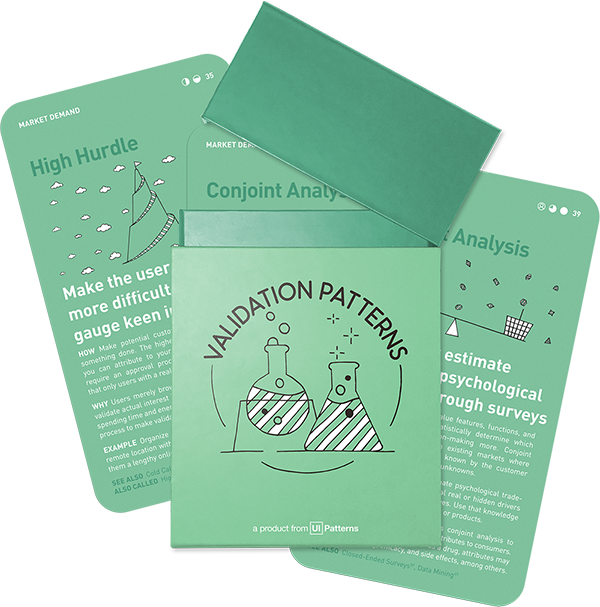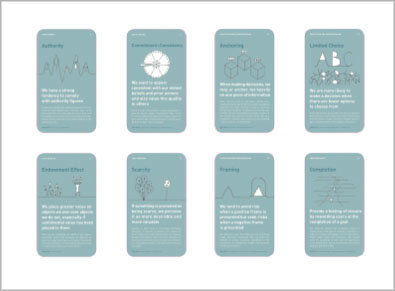Idea Validation: Product
Net Promoter Score (NPS)
Ask how likely your customers are to recommend your product to others

How: Ask your customers to score how likely they are to recommend your product to others on a scale of 1 to 10. Respondents are grouped into promoters (9-10), passives (7-8), and detractors (0-6). The net promoter score is calculated by subtracting the percentage of detractors from the percentage of promoters. Follow up by asking why the score was given. As you want as many responses from both detractors and promoters, keep the survey short.
Why: While NPS can help gauge customer satisfaction by separating promoters from detractors and help provide valuable insights for improvement through its open-ended questions, it fails to provide solid proof of actual validation. Also, since NPS asks about opinions rather than observing actual behavior, you need to beware of false positive results.
What is the Net Promoter Score (NPS)?
The Net Promoter Score (NPS) experiment is a widely used tool for measuring customer loyalty and satisfaction. It’s a concept that transforms a simple customer feedback metric into a powerful tool for business growth and product improvement. Let’s delve into the various aspects of the NPS experiment in more detail.
How the Net Promoter Score (NPS) works
By asking your customers to rate “How likely is it that you would recommend our company to a friend or colleague?” on a scale from 1 to 10, their level satisfaction is gauged. To obtain the Net Promoter Score, participants are categorized into three groups depending on how they answered:
- Pomoters. Those who gave a rating between 9 and 10
- Passives. Those who gave a rating between 7 and 8
- Detractors. Those who gave a rating between 1 and 6
| Detractors | Passives | Promoters | |||||||
|---|---|---|---|---|---|---|---|---|---|
| 1 | 2 | 3 | 4 | 5 | 6 | 7 | 8 | 9 | 10 |
| Not at all likely | Neutral | Extremely likely | |||||||
The Net Promoter Score is calculated by subtracting the participant percentage of Detractors from the percentage of Promoters:
Net Promoter Score = % Promoters - % Detractors
The result will be a number ranging from -100 to 100 where any score above +40 is generally excellent. This can, however vary from industry to industry. There is no fixed rule.
The number itself reveals only little
Calculating your NPS on a regular basis is good practice and will allow you to spot and react to any significant sudden changes. However, just looking at the score itself reveauls little about why users answered like they did. This is why it is vital to follow up with qualitative surveys asking open-ended questions related to the experience and value your product or service delivers.
Implementing Net Promoter Score Suveys
Companies usually implement NPS surveys after significant interaction points, such as post-purchase or after customer support interactions. This timing is crucial as it captures the customer’s sentiment when their experience with the product or service is most vivid.
Timing is critical – sending the survey immediately after a purchase or interaction can yield more accurate and honest responses. This distribution can be facilitated through various channels like email, in-app notifications, micro surveys, or even SMS, depending on where customers are most engaged. Automation tools can also be used to trigger these surveys at the optimal moment, ensuring consistency in data collection.
Closing the feedback loop
A crucial part of the NPS experiment is closing the feedback loop. This involves reaching out to customers, especially Detractors, to address their concerns. It shows customers that their feedback is valued and acted upon.
Closing the feedback loop is a multi-step process. Initially, it involves categorizing the feedback from the NPS survey into actionable segments. This categorization helps in understanding what specific changes would most impact customer satisfaction. For example, feedback from Detractors might highlight issues that need immediate attention, while insights from Promoters can identify strengths to build upon.
The next step in closing the loop is directly engaging with customers, especially those who have provided negative feedback. This engagement can take various forms, such as personalized emails, phone calls, or even face-to-face meetings, depending on the severity of the feedback. The key is to show customers that their opinions are valued and that the company is committed to addressing their concerns. This proactive approach can turn Detractors into Promoters, demonstrating the company’s dedication to customer satisfaction.
Tracking NPS long-term
NPS is not a one-time metric but a long-term tracking tool. Companies monitor their NPS score over time to assess the effectiveness of their strategies in improving customer satisfaction and
For long-term tracking, it’s essential to establish a system for regularly monitoring and analyzing NPS scores. This continuous analysis helps in identifying trends, understanding the impact of specific changes, and making informed decisions. It’s not just about tracking the score itself, but also understanding the underlying reasons for any shifts in the score. Tools and dashboards can be used for real-time tracking and to disseminate insights across the organization.
Additionally, integrating NPS tracking with other metrics and business KPIs can provide a more holistic view of customer satisfaction and loyalty. This integration allows for correlating NPS data with other business outcomes, like repeat purchase rates, churn rates, and overall revenue. By doing so, companies can better understand the ROI of their customer experience initiatives.
NPS should be viewed as a dynamic tool, one that evolves with the company’s growth and market changes. Regularly revisiting the NPS strategy, survey design, and analysis methods is crucial to ensure that the system remains relevant and effective. Companies that successfully implement NPS as a long-term strategy often foster a culture of continuous improvement, where customer feedback directly influences business strategy and product development.
Real life Net Promoter Score (NPS) examples
Taylor & Hart
Using NPS as their core metric, the jewelry company found that customers were reluctant to buy a ring from an online-only retailer. Resending the survey 40 days after purchase, they fixed their shipping process too.
Source: How this ecommerce company grew 2x by making NPS their most important metric
Slack
Slack employs in-app NPS surveys with a casual, friendly tone, introducing team members to personalize the experience. This approach makes the surveys more approachable, enhancing user engagement and quality of feedback.
Source: In-App Surveys Guide for Collecting Valuable Feedback
MasterClass
MasterClass triggers an NPS survey after a user completes one of its courses, ensuring timely and relevant feedback on their course content.
Source: 5 Interesting Ways Real Companies Use Net Promoter Score Results
Groove
The revenue platform follows up with customers who leave poor scores to understand their experiences better and to provide personalized solutions
Source: 5 Interesting Ways Real Companies Use Net Promoter Score Results
HubSpot
HubSpot integrates NPS into its customer service analytics, using it alongside other tools to gain a comprehensive understanding of customer experiences and preferences.
Source: 5 Interesting Ways Real Companies Use Net Promoter Score Results
Metro Bank
Metro Bank leveraged NPS by engaging customers through surveys post-interaction, capturing real-time feedback to enhance service quality in the financial sector.
Source: Highest NPS Scores: Best NPS Scores From Top Companies In 2023
Metro Bank
Metro Bank leveraged NPS by engaging customers through surveys post-interaction, capturing real-time feedback to enhance service quality in the financial sector.
Source: Highest NPS Scores: Best NPS Scores From Top Companies In 2023
A collection of 60 product experiments that will validate your idea in a matter of days, not months. They are regularly used by product builders at companies like Google, Facebook, Dropbox, and Amazon.
Get your deck!Related plays
- The Startup Physical: What’s Your Net Promoter Score? by Glen Hellman
- What is Net Promoter by Netpromoter.com
- The Real Startup book - Net Promoter Score Survey by Tristan Kromer, et. al.
- What is Net Promoter Score (NPS) and When to Use It by Matt David & Mike Yi

